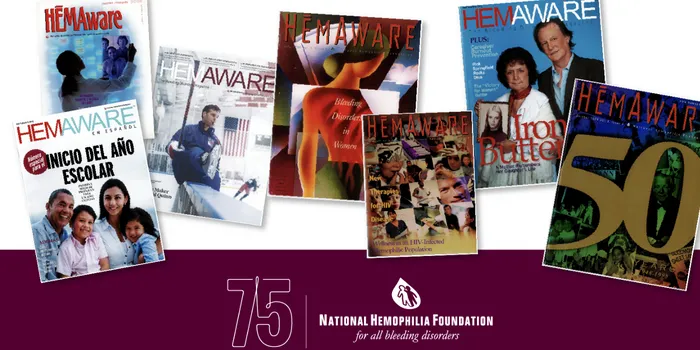The National Hemophilia Foundation (NHF) celebrates its 75th anniversary in 2023. Throughout the year, HemAware.org will be commemorating this special milestone with articles that look back at notable programs, initiatives, and events in NHF’s history.
In 1996, the National Hemophilia Foundation (NHF) published its first issue of HemAware magazine. (The magazine, which is printed two times a year, also went digital in 2010, and Spanish translated content was added in 2014.) Over the years, the blood and bleeding disorders community has come to rely on the publication as a trusted source for inspiring stories, practical health information, research updates, analysis, and foundation news.
Neil Frick, senior vice president for medical programs and information at NHF, says the decision to create the magazine largely stemmed from the community asking the foundation for more information on specific topics about blood and bleeding disorders. “We’d always done newsletters, but they didn’t have the kind of in-depth articles on topics that related back to the community, and so we realized that we needed to create a magazine that would meet that need,” he says.
Frick adds that many of the articles in the first issues of HemAware were sparked by requests for information from patients and their caregivers that came through HANDI, NHF’s information resource center. “If we got several requests for information about a particular topic, then we’d decide that we needed to do an article in HemAware so we could provide our patient community and their families with the resources they were asking for,” he says.
Notable Highlights
In addition to providing health information on topics of interest to the community, the magazine has covered key achievements in blood and bleeding disorders advocacy, including the landmark Ricky Ray Hemophilia Relief Fund Act, which was signed into law in 1998 by then-President Bill Clinton. The act provides compensation to people with hemophilia (and their families) who were treated with HIV-contaminated factor products between 1982 and 1987.
“This was a major win for the entire blood and bleeding disorders community, and so we made it a cover story in HemAware,” Frick recalls. “We were so proud of that achievement that we framed that cover and had it hanging in our offices for quite a while.”
Frick says another big topic that was covered in early issues of HemAware was hepatitis C, since many people who received plasma-derived clotting factor in the 1970s and 1980s ended up being infected with the hepatitis C virus. “We did a cover story on liver transplants that was very popular because it helped explain the topic in great detail,” Frick recalls. “We wanted our community to understand that it’s not as simple as just giving someone a transplant, especially when they also have a bleeding disorder. It’s a lifelong issue.”
The fact that women can also have bleeding disorders is common knowledge today, but back in the early days of HemAware, that wasn’t the case. “I remember the first real women’s issue we did featured a woman’s face on the cover,” Frick says. “At that time, most people thought that women could only be carriers, and so that cover story really helped educate our community that many women were going undiagnosed.”
Awards and Recognitions
HemAware magazine and its website have received several awards and recognitions over their history. Most recently, the magazine was a finalist in two categories (Best Feature Design and Best Use of Illustration) in the 2022 Content Marketing World awards, and in 2019, the “Embracing Intimacy” issue won Best Overall Design in Folio magazine’s Ozzie Awards.
To subscribe to HemAware magazine, click here.

